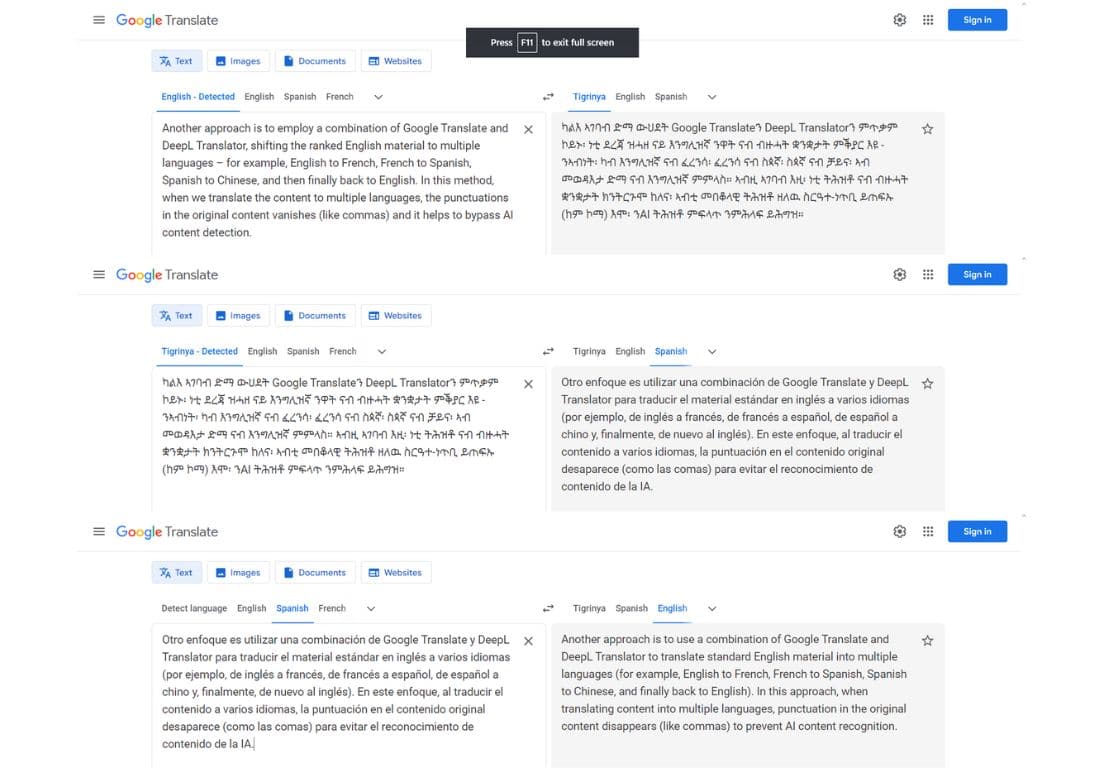In this blog post, you will learn how to detect AI generated content and How to avoid AI detection with different methods and techniques!
- What is AI generated content?
- What is AI Detection and How Does It Work?
- Why Is AI Detection a Concern for Content Writers?
- How Can AI Detect Content Written with AI?
- Why Is AI Content Detection Important?
- Common Characteristics of AI-Generated Content?
- How to Detect AI Generated Content (ChatGPT) vs Human Generated Text?
- 1. Look for Repetitive or Unusual Patterns in the Text
- 2. Run a Quick AI Query And Compare
- 3. Check for Lack of Originality
- 4. Review Outdated Inaccuracies
- 5. Perform a Contextual Analysis
- 6. Use an AI Content Detector Tool:
- How accurate are ChatGPT AI detectors?
- Will Using AI Content Lead to Google Penalties?
- How to Avoid AI Detection of AI Generated Content?
- What Are Some Other Tips for Creating Content That Is Not Detected by AI?
- Final Thoughts
Introduction:
Content online that seems too good might be made by Artificial Intelligence(AI). AI can make things like writing, pictures, music, and videos that look like they’re created by people. You can see it all over the place today.
AI has made new jobs and caused some trouble too. Now, students are thinking about whether it’s okay to use AI written content in schools. They’re also trying to figure out how to get rid of AI detection of these content from AI detection tools.
People are worried about what’s right and wrong, like in photo contests. It shows how important it is to think about ethics even though AI can make lifelike photos to win in photo contests.
What is AI generated content?
AI-generated content(AI Content) refers to text, images, or other media produced employing artificial intelligence algorithms, free direct human input. This content is created based on patterns and data fed to AI models, resulting in output that resembles human-created content.
What is AI Detection and How Does It Work?
| AI Detection | How It Works |
| Definition: | Identification of content generated by artificial intelligence systems. |
| Process: | Analyzes data patterns and characteristics to differentiate between AI-generated and human-created content. |
| Techniques: | Utilizes natural language processing, machine learning algorithms, and pattern recognition. |
| Goal: | To accurately identify and flag content produced through automated processes. |
Why Is AI Detection a Concern for Content Writers?
- Threat to Authenticity: AI detection poses a threat to the authenticity of content created by writers.
- Risk of Reduced Engagement:Detection of AI-generated content can lead to reduced engagement and interaction with the audience.
- Impact on Reputation:Content writers risk damaging their reputation if AI detection reveals a reliance on automated content creation.
- SEO and Ranking Challenges: AI detection may result in lower search engine rankings, affecting the visibility of content writers online.
- Trust and Credibility Issues: Content writers may face trust and credibility issues if their audience discovers a significant amount(50% and above) of their content is AI-generated.
- Competition with AI: The prevalence of AI-produced content raises concerns about content writers competing with AI for opportunities and recognition.
How Can AI Detect Content Written with AI?
AI can detect content written with AI through various methods, including:
- Natural Language Processing (NLP):
- Machine Learning Algorithms:
- Pattern Recognition:
Natural Language Processing (NLP):
NLP techniques analyze and interpret human language data. AI systems can use NLP to identify patterns, grammar structures, and semantics in text generated by other AI systems.
Machine Learning Algorithms:
Machine learning algorithms can be trained to recognize the characteristics of AI-made content. By analyzing large datasets of both human and AI-generated text—these algorithms can learn to distinguish between the two.
Pattern Recognition:
AI can detect content written with AI through pattern recognition. By identifying unique patterns or signatures in the text (generated by AI models), other AI systems can flag suspicious content that is authored by AI.
Why Is AI Content Detection Important?
We’ve seen firsthand what can happen when AI-generated content runs unchecked. Fake news and deepfakes have become rampant, shrouding the internet in uncertainty. I believe that AI detection is essential for upholding truth and building trust–it’s how we protect ourselves from manipulation and protect the integrity of our shared values.
It’s not just about academics or artists; it’s about preserving democratic processes and keeping us safe from fraudsters. Technology has such potential for good, but only if we use AI detection to its fullest extent can we fully reap its benefits.
Common Characteristics of AI-Generated Content?
To detect AI-generated content, you need to know how AI content is written and the structure of the sentences etc. Now, we are going to move deeper into this topic
Understanding AI-generated content
As someone who loves to explore the endless possibilities of AI technology, I’m always amazed by how far it has come. With neural networks and transformers, modern language models can accurately generate text by predicting the most likely next word based on the previous context.
GPT-4 is a prime example of this incredible power. It has billions of parameters and even captivates our thoughts with its human-like intelligence. There’s no denying how incredible this technology is and I’m excited to see what else it can do!
Characteristics of AI-generated content
- Language patterns and style are consistent with ChatGPT responses.
- Unusual or uncommon phrasing is not typically used by humans.
- Immediate and rapid responses without delays.
- Overuse of certain phrases or repetitive patterns in the content.
- Lack of personal experiences or subjective opinions in the writing.
- Absence of nuanced understanding or contextual comprehension.
- Inconsistent or illogical reasoning within the content.
- Limited ability to engage in complex or abstract discussions.
- Unnatural or robotic-sounding language and lack of emotional expression.
- Identifiable errors or limitations in factual accuracy and knowledge.
How to Detect AI Generated Content (ChatGPT) vs Human Generated Text?
In this section, let’s dive into the world of methods, tools, and techniques I’ve come across to detect if content is created by ChatGPT. Throughout my experiences, I’ve compiled a collection of commonly used approaches to determine the origin of the content.
These methods have proven helpful in distinguishing whether the content is the result of ChatGPT or not. Let’s explore these techniques and shed some light on how to detect AI-generated content.
1. Look for Repetitive or Unusual Patterns in the Text
To detect if the content is created by ChatGPT, look for repetitive or unusual patterns in the text. Keep an eye out for recurring phrases, uncommon language patterns, and repeated words or sequences. Notice any unusual sentence structure, grammar usage, or consistent errors.
Pay attention to excessive repetition of ideas and concepts, as well as a lack of natural variation in writing style. Be alert to abrupt shifts in tone or topic within the text. These clues can help identify content that may have been generated by ChatGPT.
2. Run a Quick AI Query And Compare
To determine if the content is from ChatGPT, run a quick AI query and compare the responses. Check for identical or highly similar answers from ChatGPT, as well as the response time and speed of producing content. Compare the output with known patterns or templates used by ChatGPT.
Analyze the coherence, logical consistency, creativity, and originality of the text. Also, evaluate the accuracy of factual information provided in the response. By considering these factors, you can identify if content may have been generated by ChatGPT.
3. Check for Lack of Originality
To find out if ChatGPT created the content, check for a lack of originality. Look for content that closely resembles existing sources or materials, indicating potential plagiarism or unattributed copying. Analyze the presence of common phrases or clichés. Assess the uniqueness of ideas and perspectives presented, evaluating the level of creativity and original thought.
Compare the text with known templates or pre-existing responses. Notice if there is over-reliance on scripted or generic language, as well as a lack of personalization or customization in the content. These signs can indicate that the content may have been generated by ChatGPT.
4. Review Outdated Inaccuracies
To identify if ChatGPT is behind the text, review it for outdated inaccuracies. Look for outdated information, factual errors, or references to events or data that have changed. Assess the currency of the information and compare it with recent developments or news.
Identify any inconsistencies with current knowledge or understanding. Notice outdated terminology or usage. Recognize historical context that is no longer relevant. By scrutinizing these aspects, you can identify content that may have been generated by ChatGPT.
5. Perform a Contextual Analysis
To figure out if the content is ChatGPT-generated, perform a contextual analysis. Draw on personal experiences to evaluate the authenticity of information and apply real-world knowledge. Consider if the content aligns with your beliefs, reflects cultural nuances, and resonates with your understanding.
Assess the appropriateness of the response in a given situation. Notice if the text lacks depth or understanding of personal experiences. Apply critical thinking to evaluate the logic and coherence of the content. By considering these factors, you can identify if content may have been generated by ChatGPT.
6. Use an AI Content Detector Tool:
GPTZero:

I recently discovered GPTZero, an amazing online tool developed by Princeton senior Edward Tsai. It’s touted as a powerful tool for detecting AI-generated content, perfect for educators needing content detection solutions. The program works by analyzing text complexity, sentence structure, — and even ‘perplexity’ to determine if the content is created by ChatGPT.
Having used their free version to check 5,000 characters per document, I was amazed at the accuracy of its results. If you’re willing to pay for the Pro Plan, you get access to a more advanced AI model and increased checks.
For educators, GPTZero offers GPTZero Educator – a tailored tool with features designed for their specific needs. It allows them to easily handle larger amounts of text in multiple formats.
Personally, I think this is an invaluable tool that should be used as part of a holistic assessment, rather than solely relying on it to punish students. With all the advancements in content detection methods, tools like GPTZero are becoming increasingly accurate and effective. Worth checking out!
Copyleaks

I remember in 2015, Alon Yamin and Yehonatan Bitton, who had a background in military-grade text analysis from their time in the Israeli Defense Forces, founded Copyleaks. This beloved online tool specialized in authenticating and identifying ownership of content (including AI generated content). It provided a much-needed solution for content creators and educators to verify if the content had been written by an individual or artificial intelligence.
With features such as plagiarism detection, AI content detection and AI governance solutions, it seamlessly integrates into existing platforms and systems through API integration. Millions worldwide trust Copyleaks, big businesses, educational institutes and individuals alike, taking advantage of its free daily limit feature, too.
What’s more, it’s SOC 2 Type II certified and PCI DSS compliant to ensure security and privacy. Plus, its founders’ diverse culture values unique ideas and perspectives. There are case studies, blogs and help centers available to support users too! All in all, this amazing tool is accessible globally with offices in the US and Israel.
Other Tools
While GPTZero and Copyleaks are recognized as popular tools for detecting ChatGPT-generated content, there are other options available on the market. Content at Scale, Originality.ai, Writer, and ZeroGPT are among the alternative content detection tools that users can explore.
However, based on personal testing experiences, GPTZero and Copyleaks have proven to offer better accuracy, speed, and consistent results across repeated tests. It is recommended to try each tool individually to determine personal preferences and identify the best fit for specific use cases. Copyleaks, for instance, provide rapid results but may impose limitations on trial usage or daily quotas.
However, users can extend their limits by utilizing a virtual private network (VPN) to bypass these restrictions. Ultimately, selecting the most suitable content detection tool depends on individual requirements and preferences.
How accurate are ChatGPT AI detectors?
Let’s talk about the accuracy of AI content detectors. Many tools claim to be accurate in detecting AI-generated content. In fact, Copyleaks even claims to be the most accurate AI content detector in a recent study.
Is it possible for AI detectors to be wrong?
Here’s the thing – no tool is perfect. Sometimes, even without the assistance of AI, these tools flag originally human-written content as AI-generated. It can be frustrating when you put in your effort and it gets misinterpreted.
What’s interesting is that if you use different tools to detect AI, you’ll get different results. One tool may flag a higher percentage or probability of human-written content, while another tool may provide different results altogether. It’s like flipping a coin and hoping for consistent outcomes.
Every month, I see new AI detector tools being launched, and they all promise to accurately spot AI content. But listen up: these detectors often get it wrong and mistakenly label human-created content as AI-generated. This creates numerous problems, particularly for educational institutions that heavily depend on these tools.
From my experience, even after considering Originality.ai, I can tell you that there is currently no flawless AI detector that can reliably determine whether a piece of content is AI-generated or written by a student or blogger. It’s a challenging dilemma that we still need to find a solution for.
Will Using AI Content Lead to Google Penalties?
That’s a question on the minds of many. Whether you have a blog or are thinking of starting one, it’s natural to wonder about the consequences of using AI-generated content. As of now, there isn’t a perfect tool to detect AI-written content with 100% accuracy. While most browsers have integrated AI to provide search results, it’s clear that AI isn’t going away anytime soon.
Google may have some AI detection tools in place, but they aren’t foolproof. They can’t guarantee whether the content is human-written or AI-generated. So, using AI won’t necessarily result in penalties from Google. However, it will impact your rankings. Why? Because Google prioritizes content that engages readers and leaves a lasting impression.
If you rely solely on AI to create your content, the quality will suffer. Readers can quickly sense it and may close the page or bounce back to search results immediately. This lack of engagement will directly affect your rankings.
When it comes to Google, it’s all about quality over quantity. Sure, they’ve got systems in place to catch spammy and scraped content—SpamBrain is a great tool for this—but the real determining factor of how your content is treated on Google is whether it’s useful or not.
If you’re providing value to users with your AI-generated content, making sure it answers their questions effectively, then Google will treat it favorably. However, if you’re just scraping or producing poorly generated content, that’s probably going to be met with a negative response. So, although there’s no penalty for using AI-generated material, it may still harm your ranking if you lean into it too heavily.
Bottom line: when it comes to Google rankings, it pays off to make sure your blog is high-quality content, captivating, and adds something worthwhile to the reader. Keep these things in mind.
How to Avoid AI Detection of AI Generated Content?
There are many ways or methods you can follow to avoid AI detection of your content written with ChatGPT or any other tools.
| 1. Write Original Human Content |
| 2. 50:50 Writing Method |
| 3. Multiple Translation Method |
| 4. Replace words with Synonyms Method |
| 5. Paid Tools Conversion Method |
1. Write Original Human Content
This is the easiest and best method to avoid AI detectors from your AI generated content. It is also a safe method. There are a lot of AI writing tools that will be born in the coming years, but no one can replace human writing as AI cannot think like a human to write content with their personal experiences and expertise.
Moreover, Google loves high-quality human writing more than high-quality AI content. Human written content only will rank higher positions of SERPs.
2. 50:50 Writing Method
Steering clear of AI detection is only possible if you produce human-original content with a unique vision. Simply copy and pasting from search engines or using spun material through Quillbot (a popular paraphrasing tool) will no longer suffice.
In this 50:50 writing method, content is generated with AI but 50% of content is modified with human intervention. You have to edit each sentence one by one to prevent your content not to being detected by AI tools.
If you edit the content randomly, there is a high chance of getting flagged as your content is AI generated. The 50:50 writing method will guarantee your content is 100% human written.
3. Multiple Translation Method

Another approach is to employ a combination of Google Translate and DeepL Translator, shifting the ranked English material to multiple languages – for example, English to French, French to Spanish, Spanish to Chinese, and then finally back to English. In this method, when we translate the content to multiple languages, the punctuations in the original content vanishes (like commas) and it helps to bypass AI content detection.
Occasionally this method yields unique results, but more often than not it fails to capture the true essence of the content. If you incorporate your personal experiences and opinions into the content, that helps content AI detection free.
4. Replace words with Synonyms Method
Another futile tactic is replacing certain words with synonyms; this does not alter the original meaning nor attain the desired outcome. People used to rely on tools like – Quillbot for word replacement, which was effective at that time.
However, the effectiveness of such tools has diminished over–time, and now, most AI detection tools flag content spun with Quillbot. This highlights the growing awareness and scrutiny of artificially generated or manipulated content, emphasizing the importance of creating original and meaningful content.
You can use Grammarly, Prowritingaid, and Google Dictionary extensions to replace words with alternative words or synonyms to make your content AI-detection-free. But always make sure that each synonym must be the exact meaning of the words you are replacing with.
5. Paid Tools Conversion Method
There are many online tools available to convert the Ai generated content to 100% human-written content to avoid ai detection tools. The most popular tools are Undetectable AI and stealthwriter.ai,
Undetectable AI
Undetectable AI is an innovative tool created to detect and humanize AI-generated text, guaranteeing content bypasses AI detectors with ease. By leveraging sophisticated AI algorithms and refined paraphrasing techniques, Undetectable AI alters AI-generated content from tools like ChatGPT and Copy.AI into human-like text that is indistinguishable from content written by a person.
This tool is ideal for writers, bloggers, researchers, and content creators looking to produce exceptional, search-engine-optimized material that confidently evades AI detection. With Undetectable AI, users can produce original, keyword-rich content that ranks well on search engines and avoids being flagged as spam. It provides a stable experience for those seeking to enhance the quality and authenticity of their writing.
- Undetectable Ai pricing starts at $9.99/month
StealthWriter AI
Stealthwriter.ai offers an extraordinary solution to transform AI-generated content into human-like text. These texts are ensured to be plagiarism-free and undetectable by AI detectors. With its Humanizer Generator, Ninja Ghost models, users can faultlessly humanize their content at Level 10, secure compelling and relatable text that resonates with the audience.
The platform’s features include bypassing AI detectors like Originality AI and Turnitin, providing 100% plagiarism-free guarantee, retaining SEO-friendly optimization, ensuring flawless content quality, presenting multiple versions for diversity, and interactive sentence alternatives. Users can also confirm their content’s undetectability with the built-in AI detector, making Stealthwriter.ai a primary tool for content creators searching for originality and proficiency in their writing.
- Stealthwriter AI pricing starts at $20/month
Note: These tools can bypass your AI content from AI detection tools, but it change your content into unreadable or moving away from the subject. So, I don’t recommend using these tools.
What Are Some Other Tips for Creating Content That Is Not Detected by AI?
Here are some tips to create content that is AI detection-free
1. Focus on Quality and Relevance
One of the mistakes new bloggers make is focusing on the number of articles created and published per month. But what if those posts are not ranked on Google?
So, always try to focus on quality and relevance. Take more time for research before writing the content.
2. Write for Humans, Not Machines
You write a lot of big paragraph content in your blog post and if that makes you happy, then remember no one will read your content. It is a common thing that humans prefer to read small paragraphs (2-3 sentences per paragraph) and if your content is junk of paragraphs, it limits their focus to read.
So, always keep in mind that you are writing for humans and not for machines.
3. Stay Up to Date on SEO Best Practices
Google rules and SEO practices always change. So, staying up to date on these will help you take proper action on time regarding your blogging journey. Join communities online and offline where SEO experts share their knowledge and expertise. You can also ask your questions to them.
Final Thoughts
If you looking for how to avoid ai detectors, the only surefire way to evade AI detection is to compose the text yourself. Brainstorm and craft your ideas into something useful and informative. Ensure that your piece satisfies the given queries.
Write in a conversational, first-person tone and style – embrace personal experiences or subjective opinions, use contractions, and brackets, and avoid overusing certain phrases or patterns, uncommon phrasing, and conventional adverbs… This is the only solution working now…




